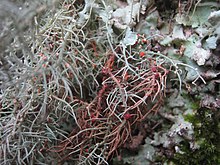Biatoropsis
| Biatoropsis | |
|---|---|

| |
| Biatoropsis usnearum | |
| Scientific classification | |
| Domain: | Eukaryota |
| Kingdom: | Fungi |
| Division: | Basidiomycota |
| Class: | Tremellomycetes |
| Order: | Tremellales |
| Genus: | Biatoropsis Räsänen (1934) |
| Type species | |
| Biatoropsis usnearum Räsänen (1934)
| |
Biatoropsis is a genus of lichenicolous (lichen-dwelling) fungi of uncertain familial placement in the order Tremellales.[1] It comprises 11 species that parasitise various species in the fruticose lichen genera Usnea and Protousnea.
Taxonomy
[edit]The genus was circumscribed in 1935 by the Finnish lichenologist Veli Räsänen, who assigned Biatoropsis usnearum as the type species.[2] The genus remained monospecific for several decades, until research, starting in the 1990s,[3] showed that B. usnearum represented a species complex. Since then another ten species have been added to the genus.[4][5]
Description
[edit]Biatoropsis is a genus of fungi that parasitises lichens (making it lichenicolous). The fungus produces reproductive structures called basidiomata that vary in both shape and colour, with a waxy-gelatinous texture similar to jelly.[5]
At a microscopic level, the internal tissue (context) consists of thread-like cells called hyphae that lack specialised connecting structures known as clamps. The fungus penetrates its host using specialised feeding structures called haustoria, which have a distinctive twisted or convoluted form characteristic of the Tremellales order of fungi. The reproductive surface (hymenium) contains numerous immature spore-producing cells called probasidia. These initially develop in a club-shaped form and may or may not have a clamp at their base. Unlike some related fungi, Biatoropsis lacks specialised sterile cells called hyphidia and cystidia in its hymenium.[5]
When fully mature, the spore-producing cells (basidia) are club-shaped to almost cylindrical and divided by cross-walls (septa). These cells develop extensions called epibasidia that are roughly cylindrical in shape. The spores (basidiospores) they produce are nearly spherical to elliptical in shape and have a distinctive side projection called an apiculus. When these spores germinate, they do so by producing a tube-like growth.[5]
The fungus can also reproduce asexually in several ways. It commonly produces chains of spores called catenulate conidia. In one rare observation, crescent-shaped (lunate) conidia were documented. In one species of Biatoropsis, the basidia themselves can function as cells that produce asexual spores – these spores are colourless and lack internal divisions.[5]
All species in the genus parasitise speciess of the fruticose lichen genera Usnea and Protousnea, causing galls in infected species.[5]
Species
[edit]As of December 2024[update], Species Fungorum (in the Catalogue of Life) accepts 11 species of Biatoropsis:[6]
- Biatoropsis angulatae Diederich & Millanes (2022)
- Biatoropsis antarcticae Diederich, Etayo & Millanes (2022)
- Biatoropsis hafellneri Millanes, Diederich, M.Westb. & Wedin (2016)
- Biatoropsis hirtae Diederich & Millanes (2022)
- Biatoropsis macaronesica Diederich & Millanes (2022)
- Biatoropsis millanesiana Diederich & Wedin (2020)
- Biatoropsis minuta Millanes, Diederich, M.Westb. & Wedin (2016)
- Biatoropsis nigrescens Diederich, Millanes & F.Berger (2022)
- Biatoropsis protousneae Millanes, Diederich, M.Westb. & Wedin (2016)
- Biatoropsis rubicundae Diederich & Millanes (2022)
- Biatoropsis usnearum Räsänen (1934)
References
[edit]- ^ Hyde, K.D.; Noorabadi, M.T.; Thiyagaraja, V.; He, M.Q.; Johnston, P.R.; Wijesinghe, S.N.; et al. (2024). "The 2024 Outline of Fungi and fungus-like taxa". Mycosphere. 15 (1): 5146–6239 [5418]. doi:10.5943/mycosphere/15/1/25. hdl:1854/LU-8660838.
- ^ Rasanen, V. (1934). "Einige neue Flechtenarten und Flechtenparasiten. 4. Biatoropsis usnearum gen. et sp. n". Annales Botanici Societatis Zoologicae-Botanicae Fennicae Vanamo (in German). 5 (9): 8–10.
- ^ Diederich, Paul; Christianse, M. Skytte (1994). "Biatoropsis usnearum Räsänen, and Other Heterobasidiomycetes on Usnea". The Lichenologist. 26 (1): 47–66. doi:10.1006/lich.1994.1004.
- ^ Millanes, A.M.; Diederich, P.; Westberg, M.; Wedin, M. (2016). "Three new species in the Biatoropsis usnearum complex" (PDF). Herzogia. 29: 337–354.
- ^ a b c d e f Diederich, Paul; Millanes, Ana M.; Wedin, Mats; Lawrey, James D. (20 August 2022). Flora of Lichenicolous Fungi. Basidiomycota (PDF). Vol. 1. Luxembourg: National Museum of Natural History. p. 351. ISBN 978-2-919877-26-3.
- ^ "Biatoropsis". Catalogue of Life. Species 2000: Leiden, the Netherlands. Retrieved 23 December 2024.
